CareerFoundry is a great course provider for a wide range of tech roles. With its flexible study schedule, its project-based curriculum, its dual-mentorship model, and an outstanding community, CareerFoundry is a battle-tested solution for securing a high-paying job in the tech job position of your preference.
CareerFoundry is an online boot camp offering flexible tech programs for career changers. Headquartered in Berlin but with a global student base, CareerFoundry has provided tech education since 2013.
CareerFoundry combines the flexibility of online learning with the guidance of mentors and tutors through their dual mentorship model, training students to become job-ready in 4 to 12 months or their money back.
Who Is CareerFoundry For?
CareerFoundry's main courses are for anyone who's interested in UX Design, UI Design, Web Development, and Data Analytics.
It's also worth mentioning that CareerFoundry has introductory courses on these topics (designed to teach you the essentials in around 1 month), and it also features advanced courses that can help designers with previous experience transition into a new specialty. These advanced courses are Voice User Interface Design, UI for UX Designers, and Frontend Development for Designers.
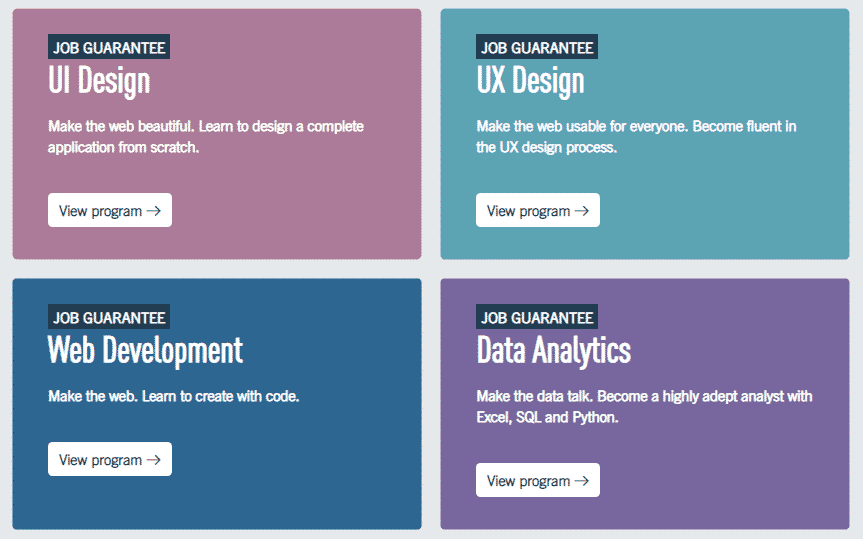
Benefits of CareerFoundry
Now that you know what CareerFoundry is and who is it for, it's time to talk about the main features that we liked from it.
#1 Flexible Study Schedule
One neat advantage that CareerFoundry has is that it gives you complete control over your schedule. The fact that you can set your own study schedule is pretty neat, but this benefit is especially advantageous if you have a busy day-to-day life, because you can also decide how many hours per week you dedicate to the course as well.
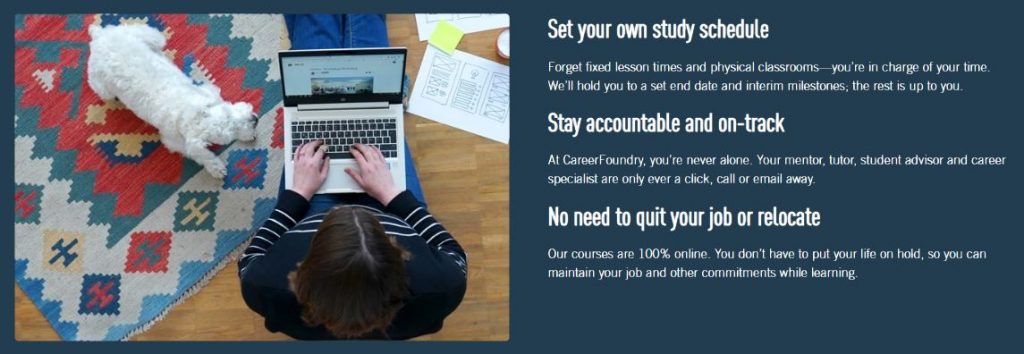
Also, CareerFoundry's classes are completely online, so not only do you avoid having to make any modifications to your schedule, but you also avoid the need of relocating, too.
#2 Project-Based Curriculum
CareerFoundry also offers its students a project-based curriculum, which is a handy feature that not every tech course provider has.
What this means is that projects you take part in during the course can be showcased in your portfolio, which helps you by making you put the skills you've learned to the test while simultaneously building a job-ready display of said skills.
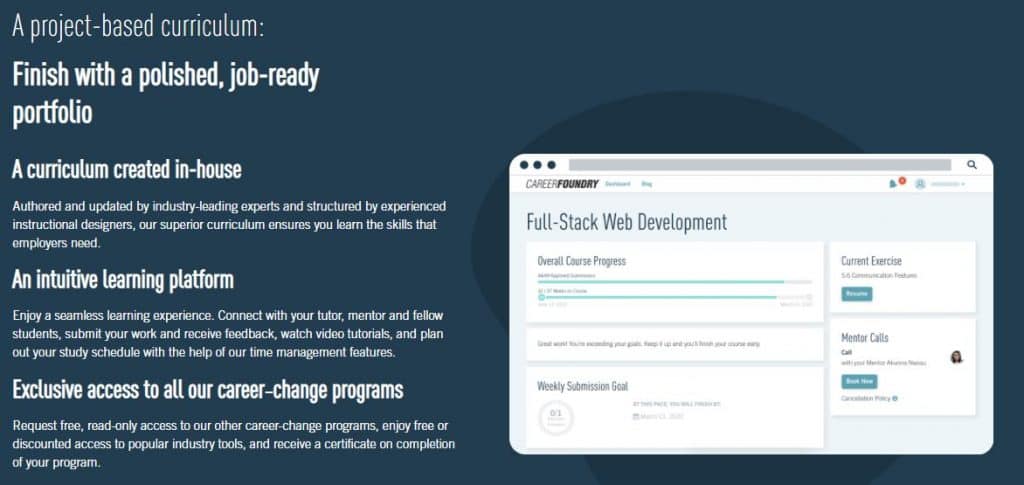
All CareerFoundry students will graduate with projects they can show to potential employers, which ensures they're job-ready once they graduate and saves a lot of time once they begin their job hunt.
#3 Dual-Mentorship Model
CareerFoundry will pair you with not one, but two dedicated experts (hailing from big tech companies like PayPal, Skype, and Yahoo!) as you're going through the course: your mentor, who will take care of supplying you with job-hunting resources, and your tutor, who will assist you with technical questions as long as it's necessary.
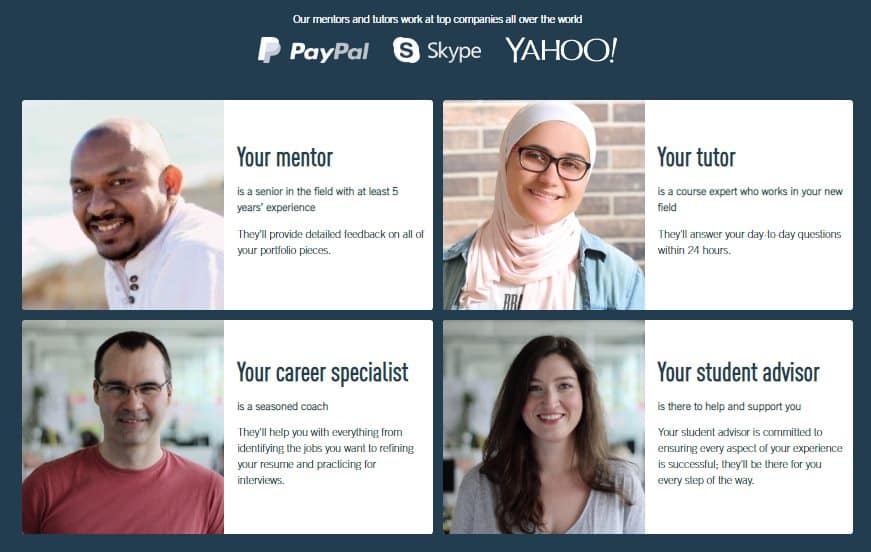
It doesn't end there, either: you will also have access to a career specialist who will provide tailored coaching for both job hunting and interviewing and a student advisor that will ensure that the entirety of your experience is successful.
It's also worth mentioning that their hiring requirements are pretty intense: CareerFoundry won't accept anyone as a mentor, tutor, career specialist, or student advisor if they don't include a first-class portfolio, a track record of top-tier work, and rock-solid references to boot (not to mention a passion for teaching).
#4 Huge Community
Being a CareerFoundry student will also grant you access to its highly active community, which is, to date, over 5,000 members strong.
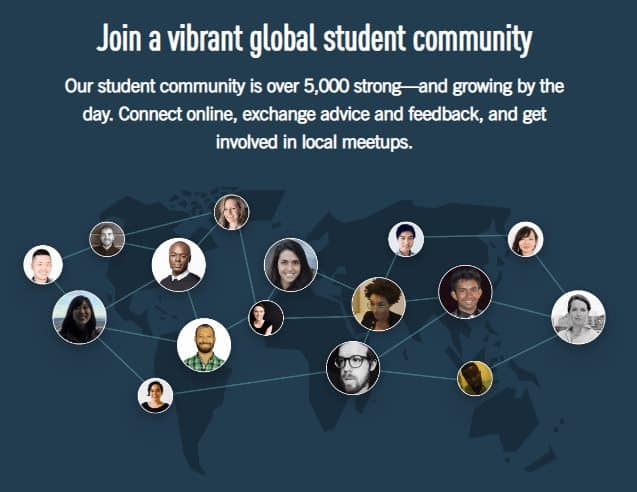
This is a bigger student community than most other tech courses out there (for example, AlgoExpert), and considering you're always allowed to exchange advice and receive feedback on any question you ask here, it's simply an invaluable resource to have.
#5 Job Guarantee
Every main CareerFoundry course also comes with a job guarantee upon reaching the end of the line.
What this means is that you'll either get a job within 6 months of graduating from the course of your choice, or you'll get your tuition back, no questions asked.
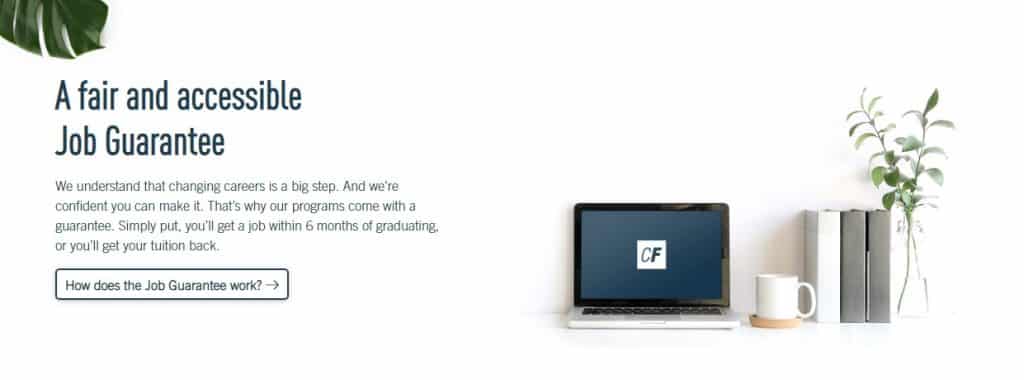
This adds a pretty wide safety net to the whole process: if you feel like the course hasn't helped you in the way you desired by the time you graduate from it and start seeking a job, CareerFoundry will actually be willing to give you a full refund without any arguments in the middle.
#6 Free Short Courses
CareerFoundry also features free short courses for absolute beginners on three main topics: UX Design, UI Design, and Web Development.
This is a great way to get started with learning the field you choose, and you'll also get complete exercises and even the basics on ways of transitioning into other tech careers.
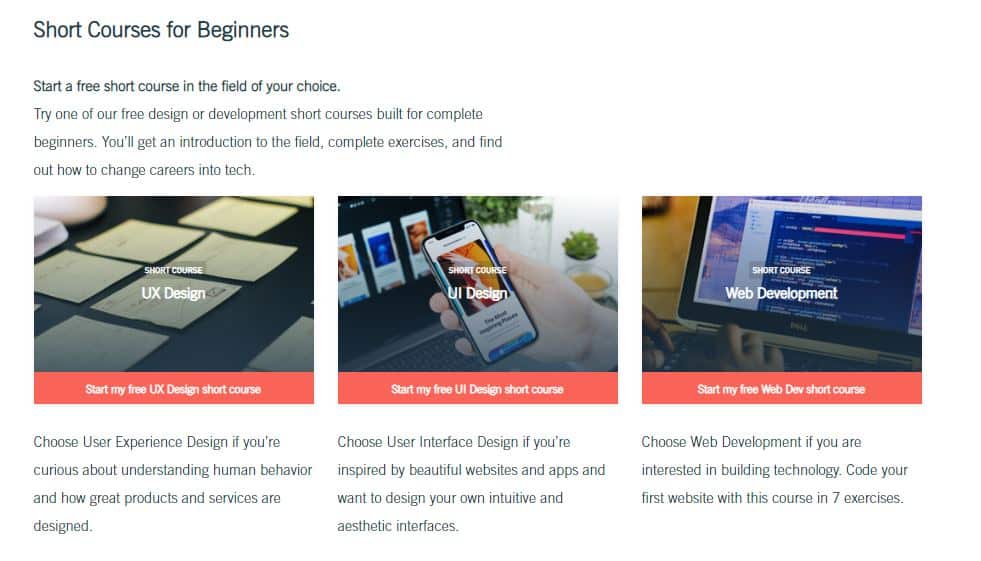
It's pretty unusual to see a feature like this one be free, and it's something that a lot more courses should do: it's a pretty strong motivator for continuing to learn.
#7 Private Slack Group
CareerFoundry also grants access to a private Slack group, a hub where past and current CF students can connect and help each other with projects, get hired, and even participate in challenges with other CF students.
Now, the existence of a private Slack group is already pretty useful, but participating in challenges with other CF students is a pretty good way of having fun while simultaneously learning how to solve tough problems through teamwork.
#8 No Previous Experience Needed
One thing you should keep in mind is that CareerFoundry's courses need no previous experience to apply for any of the main programs featured.
The only thing students of CareerFoundry should have is access to a computer, internet connection, and an interest in the topic they are planning to study.
Bear in mind, however, that this may not apply to the advanced courses which we'll talk about below.
How To Get A FAANG Job (The Easy Way)
Click below to claim your $400 discount on Tech Interview Pro today. Offer ends July 28, 2024.
CLAIM MY $400 SAVINGS
Offer ends July 28, 2024.How CareerFoundry Works
Now that you know what you can expect to get from using CareerFoundry, let's talk about the methodology they use for their teaching.
Of course, this is just a small sample of what you’ll be exposed to, but it will give you a pretty good idea of how much time was spent in optimizing the entire teaching process.
#1 Learn For The Real World
Every CareerFoundry curriculum is designed to cover the in-demand job skills required, as well as real-world tools employed by professionals in the field.
It's pretty common to see tech courses teaching you skills that won't immediately translate to what you need on the job, so it's a relief to see that the first thing CareerFoundry made sure of is that everything you learn is relevant to the job.
#2 Learn By Building
After you've gone through a few concepts, you'll be tasked with applying what you learn to hands-on projects that enhance your professional portfolio.
This means that CareerFoundry makes sure not to leave any stone unturned by teaching you every topic from both a theoretical and a practical standpoint.
And as we've mentioned before, these are projects that you can add to your portfolio, and that will easily make you be one step ahead of other candidates.
#3 Learn With Experts
Throughout the course, you will always be able to get support, feedback, and industry insights from your dedicated mentor and tutor.
Your mentor will take care of providing insight into what working in your chosen field is like, and ensures that the curriculum projects you work on align with your long-term career goals.
On the other hand, your tutor is responsible for carefully evaluating your submissions and guiding you through each exercise. They'll provide constructive feedback within 24 hours, highlighting the areas you can improve on, and where you've made the biggest steps forward.
#4 Learn To Showcase Your Work
Once you've gone through most of the course, your mentors will help you build and refine your professional portfolio.
It's also very common to see tech courses covering only the technical side of the interview (I'm looking at you, Interview Camp!), so seeing a course that also covers behavioral aspects is a breath of fresh air.
#5 Learn How To Land The Job You Want
Last but not least, your career specialist will help you fine-tune your job search and amp up your interview skills.
Again, other tech courses seldom teach you what to do after you've gone through them, and it's honestly one of the most important aspects as far as success in landing a job goes.
CareerFoundry's Courses
As mentioned before, CareerFoundry offers four introductory courses and four main courses, which we'll cover below.
#1 Intro To Frontend Development
| Location | Online |
| Class size | 25 |
| Start dates | Tuesday, March 9th, 2021 | Monday, March 22nd, 2021 | Tuesday, April 6th, 2021 | Monday, April 19th, 2021 | Monday, May 3rd, 2021 |
| Commitment (hours per week) | 15 hrs/week |
| Course length | 1 month |
The Intro To Frontend Development course will take care of teaching you basic frontend development concepts, such as:
| HTML | jQuery |
| CSS | Gist |
| JavaScript | GitHub |
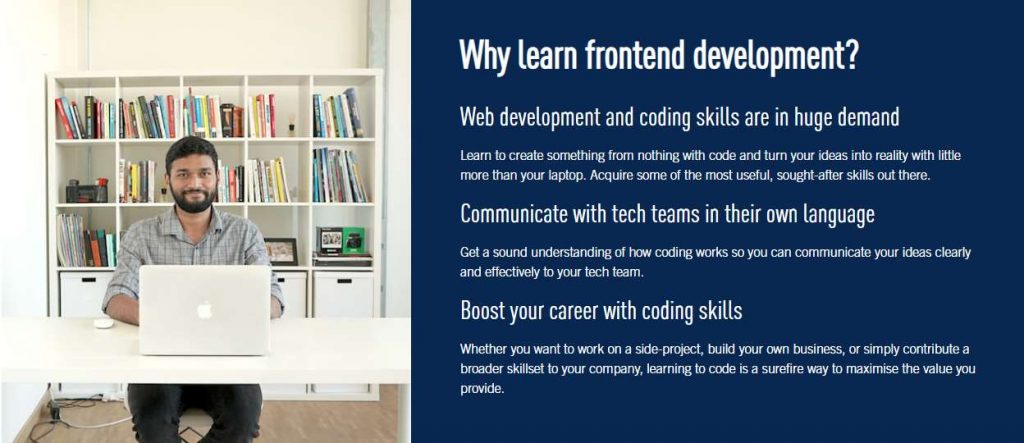
The course outline is as follows:
- Introduction & Setup: Get acquainted with the standard workflow of a web developer by learning to edit your website with a text editor, viewing it in the web browser, and uploading it to a server.
- HTML & CSS Basics: Get to know Chrome's Developer Tools, start writing your first HTML tags, and write and modify specific CSS selectors, attributes, and values.
- Create New HTML Pages: Set up a new HTML page, create and organize HTML elements, and learn how to best share your code on Gist and GitHub.
- CSS Layout & Box Model: Build the foundations of your responsive site, and get introduced to display and positioning properties. Use the box model and border boxes to adjust padding, margins, width, and borders.
- Styling Fonts & Colors: Add and style fonts to ensure browsers can properly load and render them. Start adding color to your site to bring it to life.
- Introduction To Navigation: Create fixed header navigation, style and position it, and style the navigation links using text-decoration and hover effects.
- Bootstrap Components & Plug-Ins: Learn how to use the Bootstrap framework, components, and plugins, applying and customizing it to create dynamic elements.
- Advanced Images: Add hero images to your site, and then crop and resize them with imaging software. Implement a Bootstrap carousel.
- Responsive Web Design: Use Bootstrap's grid system to create a responsive layout for desktop and mobile screens.
- Single Page Scrolling Navigation: Transform website navigation to create one long scrolling page with multiple sections. Add parallax effect with CSS and jQuery.
- Responsive Website: Using HTML, CSS, and Bootstrap, build a responsive, single-page portfolio website that fits mobile and desktop screens.
#2 Intro To UX Design
| Location | Online |
| Class size | 25 |
| Start dates | Monday, March 15th, 2021 | Monday, March 29th, 2021 | Monday, April 12th, 2021 | Monday, April 26th, 2021 | Monday, May 10th, 2021 |
| Commitment (hours per week) | 15 hrs/week |
| Course length | 1 month |
In the Intro To UX Design Course, you’ll learn about every phase of the UX design process, gain an understanding of the industry as a whole, and discover how UXers think.
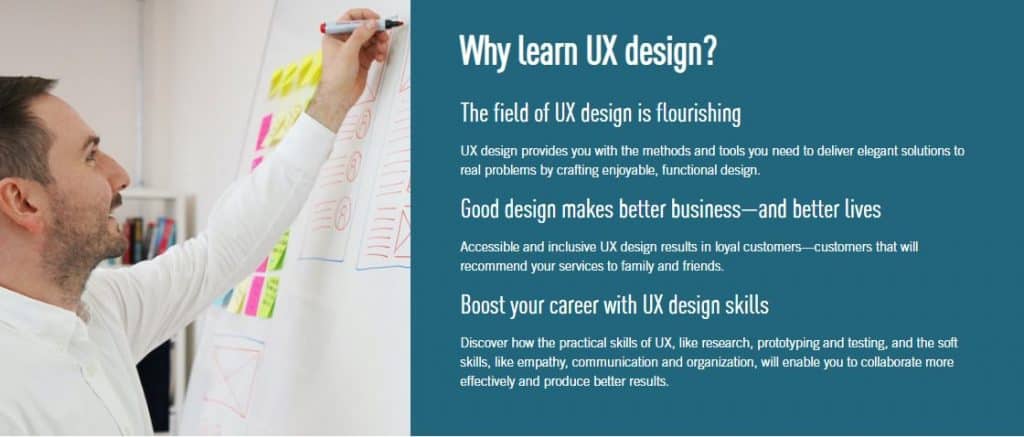
The course outline is as follows:
- An Introduction To UX And Design Thinking: Learn how to describe the UX design and design thinking processes. Apply the first stage of the design thinking process to a real-world problem and start thinking like a UX designer.
- How To Conduct Effective User Research: Discover user-centered design and strategies for conducting effective user research. Compare and evaluate research methods for different design scenarios.
- How To Build User Personas: Learn the processes for creating effective, meaningful user personas and user stories based on users' goals and needs.
- How To Analyze Information Architecture: Analyze how users navigate a site and the theory and best practices behind how information is best structured for a user's consumption.
- How To Make Wireframes And Prototypes: Learn how to turn your theoretical knowledge into something tangible and usable by creating effective prototypes and wireframes that support user goals.
- How to Do Usability Testing: Learn how usability testing should be carried out, and how to draft a testing plan for your product.
- How To Present Your Work: Present your design process and solution to stakeholders in a clear, engaging, and convincing manner, substantiating the decisions you've made every step of the way.
- A Career In UX Design?: Draft a personal design profile to map out a path for your continuing design education, and decide whether you would like to pursue a creative, rewarding career in UX.
#3 Intro To UI Design
| Location | Online |
| Class size | 25 |
| Start dates | Tuesday, March 9th, 2021 | Monday, March 22nd, 2021 | Tuesday, April 6th, 2021 | Monday, April 19th, 2021 | Monday, May 3rd, 2021 |
| Commitment (hours per week) | 15 hrs/week |
| Course length | 1 month |
In this course, you’ll learn how to build a design from the ground up, exploring the basics of design tools as you progress through the course.
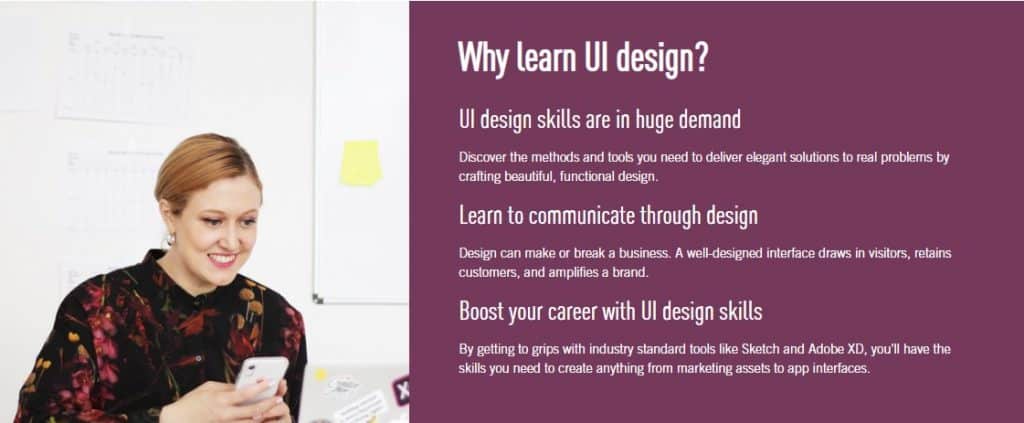
The course outline is as follows:
- What Is UI?: What is UI design? What are the typical responsibilities of a UI designer? And what's the difference between a UI and a UX designer?
- Introduction To Design Tools: Decide whether you'd like to use Sketch or Adobe XD as your tool of choice. Get a thorough overview of how to navigate your chosen tool, and its basic functions.
- Working With Layers & Shapes: Learn how to create basic shapes in Adobe XD or Sketch, and use these shapes and layers to create the first screens of your app design.
- Point Types & Boolean Operations: Take your user interface to the next level with fills, borders, and symbols. Look at Layer Styles and Symbols.
- Visual Design Basics: Master the fundamentals of visual design by adding stylistic attributes, such as color, images, and shadow to make your app visually appealing.
- Working With Text: Learn how to create typographic hierarchy as you explore how to style and format text layers in Sketch/Adobe XD.
- Advanced Tool Functions: Explore the different types of grids and masks you can use with Sketch/Adobe XD as a UI designer, and create a layout for your app icons.
- Pixel Precision: Apply the principles of pixel precision to create pixel perfect UI elements that look polished and professional.
- Previewing Your Work: Understand the importance of periodically previewing your work in the context it will be used. Learn how to preview your work by using different design preview tools.
- Preparing Your Work For Handoff: Prototype your design in InVision, and get to know the process of preparing your design work for handoff to the developers.
#4 Intro To Data Analytics
| Location | Online |
| Class size | 25 |
| Start dates | Monday, March 15th, 2021 | Monday, March 29th, 2021 | Monday, April 12th, 2021 | Monday, April 26th, 2021 | Monday, May 10th, 2021 |
| Commitment (hours per week) | 15 hrs/week |
| Course length | 1 month |
In this course, you’ll learn everything you need to gain a solid understanding of key data analysis skills, processes, and principles.
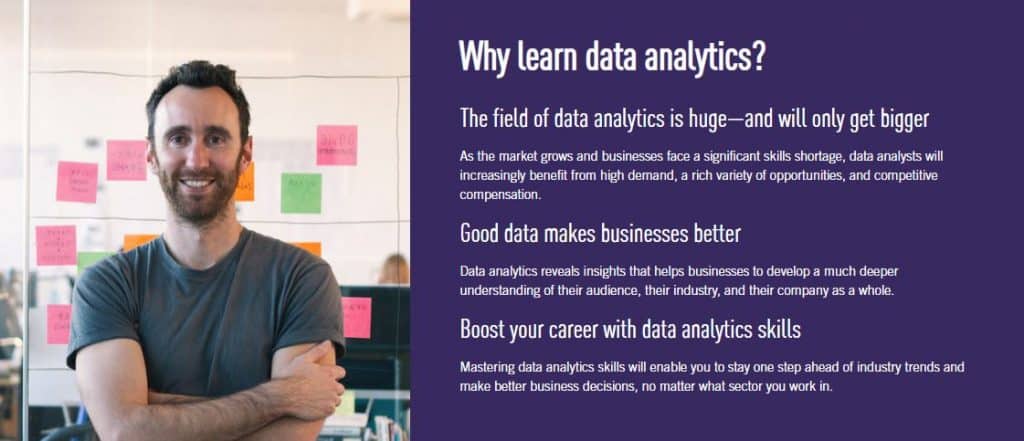
The course outline is as follows:
- Data Analytics in Practice: Learn what data analysts do, what tools they use to process data, and how they apply their skills in different industries. Prepare to kick off your own analysis by getting familiar with the dataset you’ll be working on within your course project.
- Introduction to Excel: Get hands-on with Excel, one of the primary tools used by data analysts to quickly access and generate key insights from data. Learn how to sort, filter, format, organize and create useful visualizations from a dataset.
- Understanding Your Dataset: Analyze and describe your dataset (including where it came from, how large it is, and what’s missing) in order to identify sources of bias and better understand how it relates to the problem at hand.
- Cleaning Your Data: Identify sources of error in your data, and learn how to clean your dataset to minimize potential issues.
- Organizing Your Data: Aggregate, filter, sort, and modify your dataset. Use tools like pivot tables to generate new insights about groups of records, such as trends over a time period.
- Introduction to Analytical Methods: Compare different approaches to data analysis (such as descriptive, predictive, and diagnostic), understanding when to apply each one to tackle different types of business problems.
- Conducting a Descriptive Analysis: Apply statistical methods to your dataset using Excel to complete a thorough descriptive analysis.
- Developing Insights: Form hypotheses around how a dataset will look, and generate useful insights about the data by comparing the behaviour of the data to your first estimates.
- Visualizing Data Insights: Build helpful visualizations of your data to present your findings to stakeholders. Based on the type of data you are working with, choose the most effective visualization for the problem you’re trying to solve.
- Storytelling with Data: Present the results of your analysis to others, providing a compelling narrative around old and new assumptions, and insights into a business problem.
#5 Web Development
| Location | Online |
| Class size | 25 |
| Start dates | Tuesday, March 9th, 2021 | Monday, March 22nd, 2021 | Tuesday, April 6th, 2021 | Monday, April 19th, 2021 | Monday, May 3rd, 2021 |
| Commitment (hours per week) | 15 to 30 hrs/week (depending on student availability) |
| Course length | 4 months at 30 hrs/week or up to 7 months at 15 hrs/week |
The Web Development program explores a pretty wide range of topics, such as:
| HTML | React.js | REST |
| CSS | Algorithms | SQL |
| JavaScript | Node.js | API building |
| AngularJS | Front End | Server-side development |
| MongoDB | SCRUM | Test-driven development |
| Git | MVC | Progressive web apps |
| jQuery | Agile | Native app development |
It also covers how and when to use industry-standard tools including Atom, GitHub, Node, React, Angular, Vue, and Bootstrap.
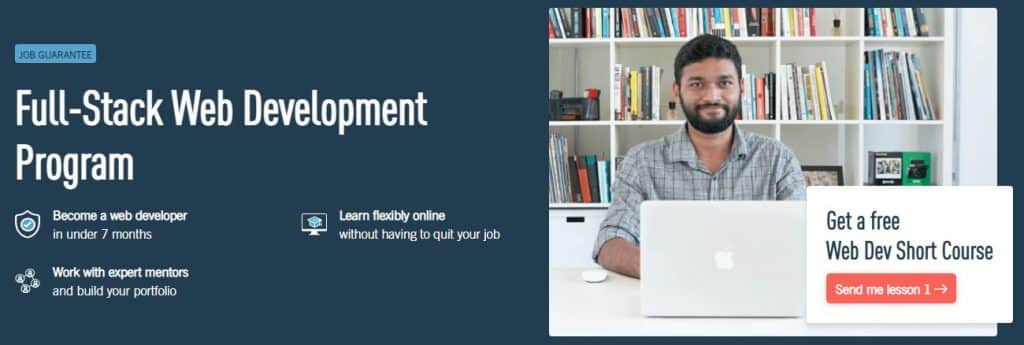
The full course is split into three parts:
- Intro to Frontend Development
- Full-Stack Immersion
- Job Preparation
As the course advances, Web Development students will create a portfolio website and a variety of apps, including a native app as well as a NoSQL, database-driven React app complete with its own API.
#6 UX Design
| Location | Online |
| Class size | 25 |
| Start dates | Monday, March 15th, 2021 | Monday, March 29th, 2021 | Monday, April 12th, 2021 | Monday, April 26th, 2021 | Monday, May 10th, 2021 |
| Commitment (hours per week) | 15 to 30 hrs/week (depending on student availability) |
| Course length | 6 months at 30 hrs/week or up to 10 months at 15 hrs/week |
The UX Design Course explores the entire UX design process, covering topics such as:
| HTML | User research and testing |
| JavaScript | Rapid prototyping |
| Design | Iterative design |
| User Experience Design | Interaction design |
| Front End | Responsive design |
The course covers the tools Balsamiq, Sketch, Figma, InVision, and more.
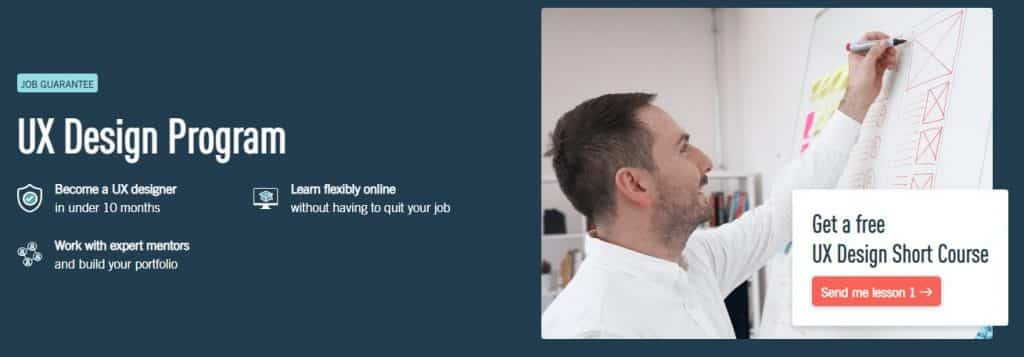
The course is split into four parts:
- Intro to UX Design
- UX Immersion
- Your choice of one specialization (User Interface Design for UX Designers, Frontend Development for Designers, or Voice User Interface Design)
- Job Preparation
As for projects, UX Design students will work on three complete apps for their portfolio, choosing from various project options (for example, the redesign of an app).
#7 UI Design
| Location | Online |
| Class size | 25 |
| Start dates | Monday, March 15th, 2021 | Monday, March 29th, 2021 | Monday, April 12th, 2021 | Monday, April 26th, 2021 | Monday, May 10th, 2021 |
| Commitment (hours per week) | 15 to 30 hrs/week (depending on student availability) |
| Course length | 5 months at 30 hrs/week or up to 9 months at 15 hrs/week |
The UI Design program explores topics such as:
| HTML | User Experience Design | Wireframing |
| JavaScript | Responsive design | Mockups |
| Design | Visual design principles | Prototyping |
| Mobile | Designing for different platforms | Testing |
As for tools, the course covers Sketch, Adobe XD, InVision, Balsamiq, Figma, and more.
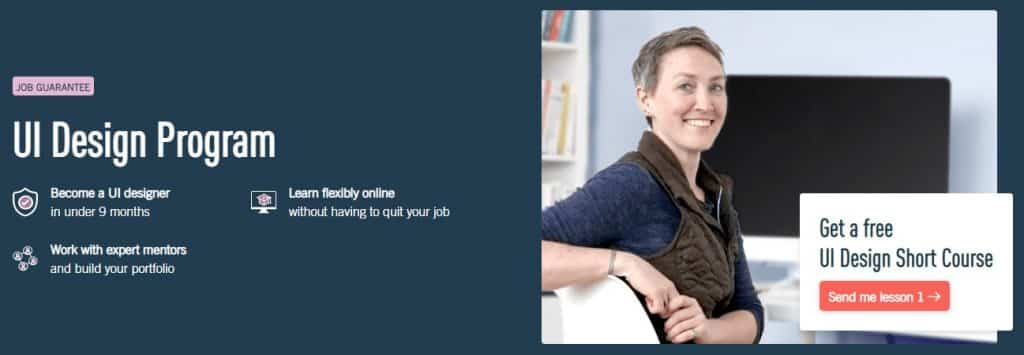
The entirety of the course is split into four parts:
- Intro to UI Design
- UI Immersion
- Your choice of one specialization (Frontend Development for Designers, or Voice User Interface Design)
- Job Preparation
As far as projects go, UI Design students build a marketable portfolio that includes the UI for eight different projects (for example, creating the brand identity and the UI design of an app).
#8 Data Analytics
| Location | Online |
| Class size | 25 |
| Start dates | Monday, March 15th, 2021 | Monday, March 29th, 2021 | Monday, April 12th, 2021 | Monday, April 26th, 2021 | Monday, May 10th, 2021 |
| Commitment (hours per week) | 15 to 30 hrs/week (depending on student availability) |
| Course length | 5 months at 30 hrs/week or up to 8 months at 15 hrs/week |
The Data Analytics program explores various topics. For example:
- Data visualization
- Data analytics
- SQL
- Python
- Statistical analysis and testing
- Data querying
- Predictive analysis
It also covers the tools Excel, TableauTableu, PostgreSQL, and more.
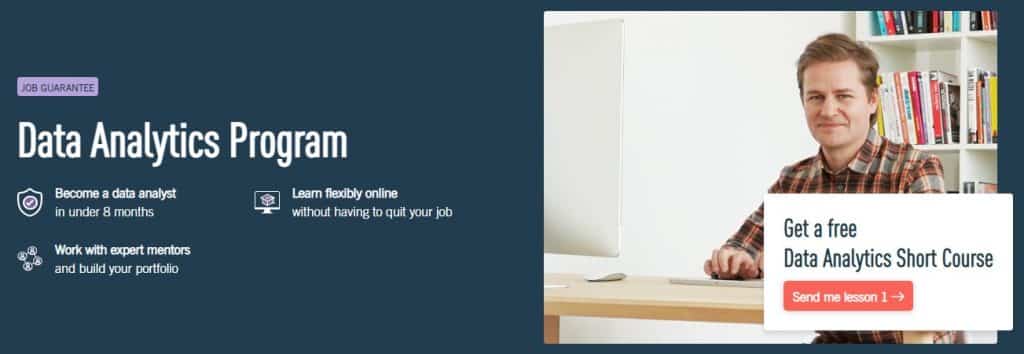
The course is split into three parts:
- Intro to Data Analytics
- Data Immersion
- Job Preparation
As far as projects go, data analytics students work on six projects, covering designing and producing visualizations, dashboards, reports, presentations, and more.
CareerFoundry's Advanced Courses
CareerFoundry offers an additional 3 advanced courses. These do require a bit of experience to get into, and they're meant to help designers who are already experienced but seek to transition to a new specialty.
#1 Voice User Interface Design
| Location | Online |
| Class size | 25 |
| Start dates | Monday, March 15th, 2021 | Monday, March 29th, 2021 | Monday, April 12th, 2021 | Monday, April 26th, 2021 | Monday, May 10th, 2021 |
| Commitment (hours per week) | 15 hrs/week |
| Course length | 2 months |
The VUI Design course will cover everything you need to know about these topics:
- History & appeal of voice
- Use cases for voice
- Personas for voice
- How Alexa voice interactions work
The tool that this course will be covering, for the most part, is known as AWS Lambda.
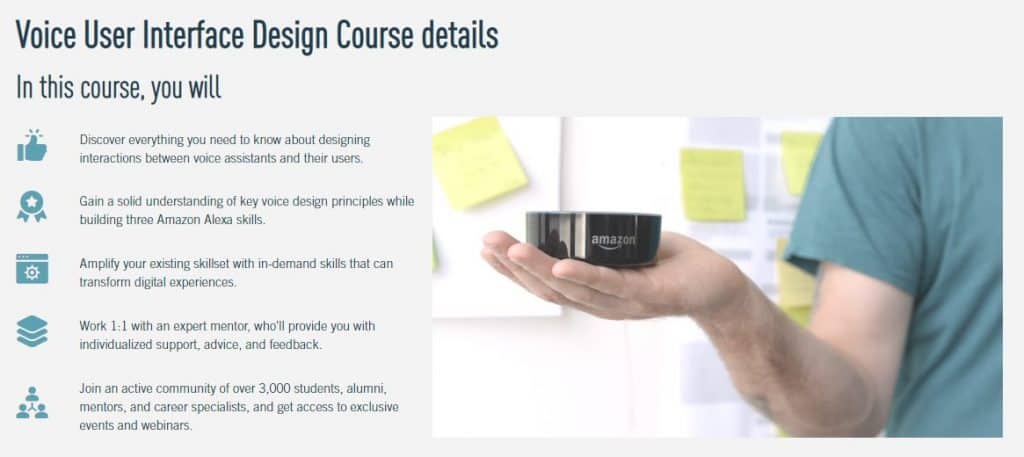
The VUI Design course outline is as follows:
Achievement #1: Introduction to Voice Design with Alexa
- Getting Started with Your Voice Design Course: Describe the role of a voice designer and identify variables and basic coding conventions.
- History & Appeal of Voice: Discuss the history of voice interactions. Outline the features of voice interfaces that appeal to users.
- Use Cases for Voice: Describe considerations for using a voice interface.
- Personas for Voice: Discuss the creation of user personas and voice interface personas.
- How Alexa Voice Interactions Work: Describe the components of an Alexa skill and how they function.
- Building Your First Skill: Set up the input side of an Alexa skill using the Amazon Skills Kit.
- Working with AWS Lambda: Describe the purpose of AWS Lambda and how to link it to a skill file.
- Certifying Your Skill: Discuss best practices in certifying a skill.
Achievement #2: UX Design Principles For Voice
- User Needs & User Stories For Voice: Apply user experience principles to create user stories for voice interactions.
- Sample Dialogs: Create sample dialogs to make design decisions about an interaction.
- User Flows For Voice: Outline effective user flows for voice interactions.
- Voice Scripts: Create comprehensive scripts using best practices for voice responses.
- Context & Memory in Voice Design: Apply the concept of memory to a voice interaction.
- Usability Testing for Voice Interactions: Describe and apply best practices in usability testing for voice interactions.
- Multimodal Interactions: Discuss appropriate multimodal approaches for user interactions.
- Accessibility & Voice: Apply usability guidelines related to accessibility to a voice interaction.
- Safety & Privacy for Voice Design: Discuss ethical challenges and user safety in voice interactions.
As for projects, VUI Design students will be tasked with designing a skill for Alexa (for example, designing a skill that allows the user to navigate and interact with a recipe primarily using voice commands).
#2 UI For UX Designers
| Location | Online |
| Class size | 25 |
| Start dates | Monday, March 15th, 2021 | Monday, March 29th, 2021 | Monday, April 12th, 2021 | Monday, April 26th, 2021 | Monday, May 10th, 2021 |
| Commitment (hours per week) | 15 hrs/week |
| Course length | 2 months |
The UI For UX Designers course will cover topics such as:
| Responsive layouts & grids | Visual design principles & trends |
| UI elements & file organization | Typography in UI |
| Visual hierarchy & spacing | Color in UI |
| UI design patterns | Imagery in UI |
The tools covered in this course are identical to the ones covered in the main UI course.
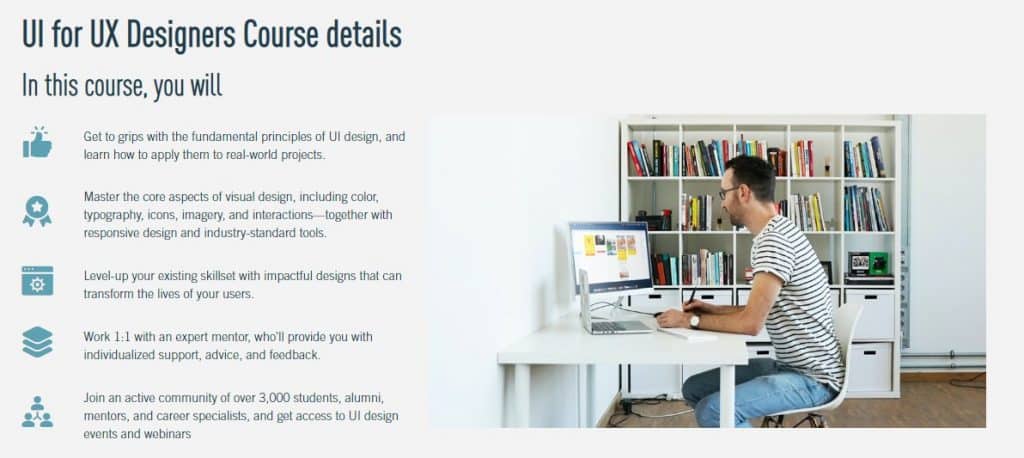
The course outline is as follows:
Achievement #1: Composition & Visual Design
- Getting Started With Your UI Course: Select a course project and create a low-fidelity prototype.
- Responsive Layouts & Grids: Demonstrate when and how to use responsive layouts and grids.
- UI Elements & File Organization: Incorporate appropriate UI elements into digital wireframes.
- Visual Hierarchy & Spacing: Establish a consistent visual hierarchy throughout a UI design. Apply the principles of good spacing to digital wireframes.
- UI Design Patterns: Incorporate existing design patterns into design.
- Visual Design Principles & Trends: Compare two different visual directions for a web app.
- Typography in UI: Apply principles of typography to web app design.
- Color in UI: Apply principles of color theory to web app design.
- Imagery in UI: Apply principles of image theory to web app design.
Achievement #2: Advanced UI & The Design Handoff
- Shapes & Icons: Construct icons using design software.
- Interactions & Gestures: Incorporate interactions and gestures into design.
- Style Guide: Compile a web app's style components in a visual style guide.
- Designing for Different Breakpoints: Adapt a design for responsive breakpoints.
- Final Mockups: Create design mockups.
- Design Handoff & Deliverables: Prepare design work for handoff.
- Final Presentation: Create an UI-focused portfolio project case study.
As for projects, UI for UX designers course students will be tasked with the same projects featured in the main UI Design course as well.
#3 Frontend Development For Designers
| Location | Online |
| Class size | 25 |
| Start date | Monday, March 15th, 2021 | Monday, March 29th, 2021 | Monday, April 12th, 2021 | Monday, April 26th, 2021 | Monday, May 10th, 2021 |
| Commitment (hours per week) | 15 hrs/week |
| Course length | 2 months |
The Frontend Development For Designers course will cover everything you need to know about these topics:
| HTML | Advanced CSS for designers | User testing |
| Using GitHub for your projects | JavaScript | Code quality |
| CSS | JS libraries & plugins | Cross-browser testing |
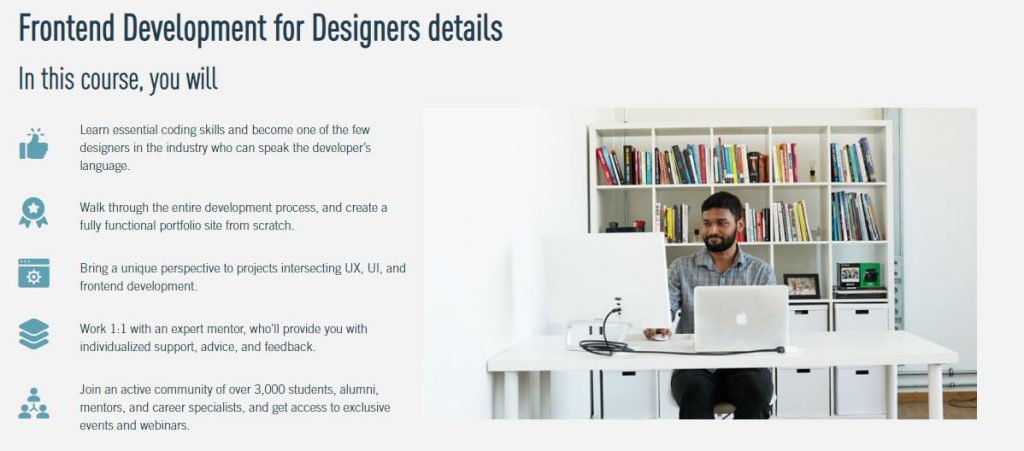
The course outline is as follows:
Achievement #1: Getting Started with HTML & CSS
- Getting Started With Your Frontend Course: Configure your developer environment. Explain the difference between front and backend development. Compile portfolio research into an inspiration board.
- Internet & the Web: Explain the basic structure of the Internet.
- Starting with HTML: Examine the architecture of an HTML web page.
- Coding with HTML: Examine the architecture of an HTML web page.
- Using GitHub for Your Projects: Discuss best practices in software development and collaboration.
- CSS Basics: Explain CSS syntax as well as how to style a basic webpage. Compare inline styling and external stylesheets.
- CSS Layouts: Discuss CSS layouts for portfolio site pages. Build a responsive layout for the portfolio site.
- Advanced CSS for Designers: Add CSS animation and transitions to the portfolio site.
Achievement #2: JavaScript & Your Portfolio Site
- Introduction to JavaScript: Describe the structure of JavaScript code.
- Coding with JavaScript: Apply your knowledge of JavaScript structure to practical situations.
- JavaScript Libraries & Plugins: Discuss the implementation of JavaScript libraries and plugins.
- User Testing: Design a project-specific testing process. Define requirements for upcoming iterations.
- Code Quality & Cross-Browser Testing: Identify common errors in HTML, CSS, and JavaScript code. Utilize code linting to avoid bugs and ensure consistent code quality.
- Portfolio Site Demo & Case Study: Discuss website hosting options. Create a video demo or case study of the complete portfolio.
As for projects, Frontend Development for Designers students can expect to see projects very similar to the ones featured in the main Web Development course.
How Much Does CareerFoundry Cost?
CareerFoundry offers two main methods of payment: a monthly subscription with an upfront fee, or a single payment for the entirety of the course of your choice.
Here are the prices for every course in CareerFoundry:
| UX Design | $550 x 10 months + $1.400 upfront $6.555 upfront (saving $345) |
| UI Design | $600 x 9 months + $1.500 upfront $6.555 upfront (saving $345) |
| Web Development | $600 x 8 months + $2.100 upfront $6.555 upfront (saving $345) |
| Data Analytics | $600 x 8 months + $2.100 upfront $6.555 upfront (saving $345) |
| Intro To UX Design | $690 upfront (with a tuition credit of $590 if you decide to upgrade to the main course) |
| Intro To UI Design | $690 upfront (with a tuition credit of $590 if you decide to upgrade to the main course) |
| Intro To Frontend Development | $690 upfront (with a tuition credit of $590 if you decide to upgrade to the main course) |
| Intro To Data Analytics | $690 upfront (with a tuition credit of $590 if you decide to upgrade to the main course) |
| Voice User Interface Design | $400 x 3 months + $800 upfront $1.900 upfront (saving $100) |
| UI For UX Designers | $400 x 3 months + $800 upfront $1.900 upfront (saving $100) |
| Frontend Development For Designers | $400 x 3 months + $800 upfront $1.900 upfront (saving $100) |
Is CareerFoundry Fake?
It's almost impossible to think about a course's legitimacy once it starts mentioning guarantees. However, CareerFoundry has one big indicator that demonstrates its not a scam, and that would be the fact that it's proven.
How, you ask? Well, for starters, CareerFoundry has a Graduate Outcomes section (featured below), and it also has hundreds of 5-star reviews and maintains an overall review score of 4.6/5 or above on every platform where it’s rated.
Read the reviews below to get a feel for what past and current students are saying about CareerFoundry!
CareerFoundry Reviews & Graduate Outcomes
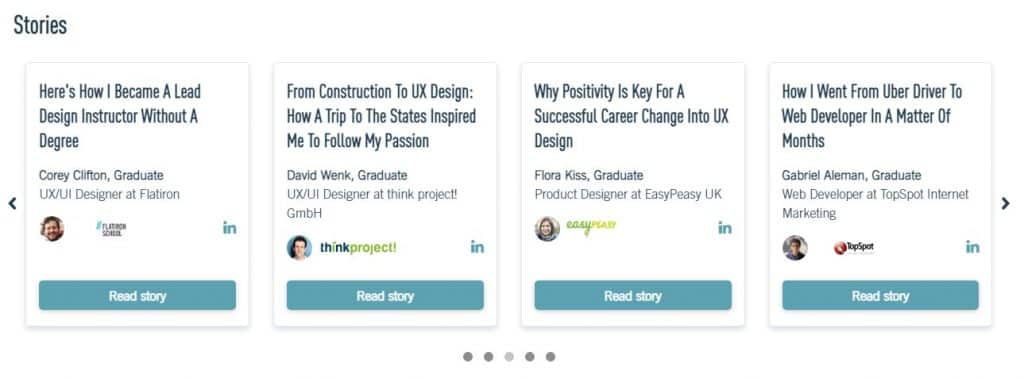
The CareerFoundry Graduate Outcomes section will allow you to read about their graduates' personal experiences both on and after graduation. It also allows you to view their portfolio projects.
Here are some of the reviews and graduate outcomes from CareerFoundry:
“I am only through a quarter of my education plan with Career Foundry and already it has blown my expectations out of the water.” Shane Saxton, UI Design
“CF's UX Immersion course is thorough, and detailed without being repetitive. They really helped me get started on my portfolio. The assistance was also superb from them. Timely, always encouraging, and helped me through the process. Definitely recommend!” Nandika Gupta, UX Design
“The mentors and tutors you get are super awesome, I have a very good connection with mine and they give valuable feedback on my work. The shared Slack channel and the community are awesome!” Ellen Sturm, UX Design
“Awesome and very much pleased with my overall experience!” Ismail Munanira, UI Design
“The mentors and tutors are very professional and extremely helpful. The course was great at covering the fundamentals preparing me for a role in a new industry.” Gage Silvery, UI/UX Design
CareerFoundry Member Stories
If the reviews section above didn't convince you, here are a few quick stories about CareerFoundry students who are currently in the course.
| Before CareerFoundry | After CareerFoundry | Do They Recommend CareerFoundry? |
| Kasia didn’t even own a computer but was on the hunt for a creative, flexible, stable career as she raised her newborn. | Kasia started working as a Ruby on Rails Developer at Startup House Development. | “It's amazing because when I started the CareerFoundry course, I had no idea what I was looking at with any of these languages! Now I can look at any programming language and understand what’s going on.” |
| Anja wanted to become a UX designer but had no idea where to start. | Anja started working as a Junior UX designer for Dept Agency. | “That was the best decision I made. I felt confident with the UX methods and tools. I actually introduced some new tools to the company!” |
| Günther's itch to learn something new started while he was working as a lawyer in Germany, and he was looking for something that would hopefully be more flexible because he also has two kids. | Günther joined as a full-time Web Developer at 3B Scientific. | “Everything worked out how I wanted it to. I had no problems during the course, doing the exercises, or with my tutor or mentor. The job application process was fine. I did it on my own and found a job quickly. I grew so much as a person, too. It was a great experience. “ |
| Marlon was a visual designer who wanted to expand her skillset and add UX Design to her toolbox. | Marlon started a project working as the lead UX Designer. | “I already started a project working as the UX Designer; I not only do the visual design, but also the UX work, and that's after 1 week of finishing the course. CareerFoundry gave me the courage to do that. “ |
CareerFoundry Frequently Asked Questions
#1 What's the refund policy if I change my mind?
If you start the program but you change your mind at any moment, you can simply cancel within 14 days and receive a full refund.
Instead, if you enroll and want to cancel before you've completed 60% of the program for any reason, you get a prorated refund based on the remaining time and your payment plan details.
#2 What's the “catch” for the job guarantee?
There are a few requirements you'll need to meet in order to be eligible for a job guarantee, and those are as follows:
- You have successfully completed 100% of your CareerFoundry program
- You are applying to at least five jobs a week
- You live in a metropolitan area with a population above 200K people in any of the following countries: USA, Canada, European Union or EFTA countries, UK, Australia, or New Zealand (or you’re willing to relocate).
#3 Do I get a certificate at the end?
Yes: you will receive a certificate when you complete the program to make your new qualifications easy for employers to see.
#4 Can I take the program for free?
Currently, CareerFoundry does not offer scholarships or funds at this time.
In Summary
Overall, CareerFoundry is a solid, thorough course provider for a variety of tech roles, and it will be an invaluable tool to help you nail your interviews and get a job in big tech. Whether you’re looking for a full-time position as a UI/UX designer, a web developer, or in data analytics, these courses will make the process a piece of cake.
If you’re serious about your job hunt and you have high demands for your career, we highly recommend CareerFoundry.


